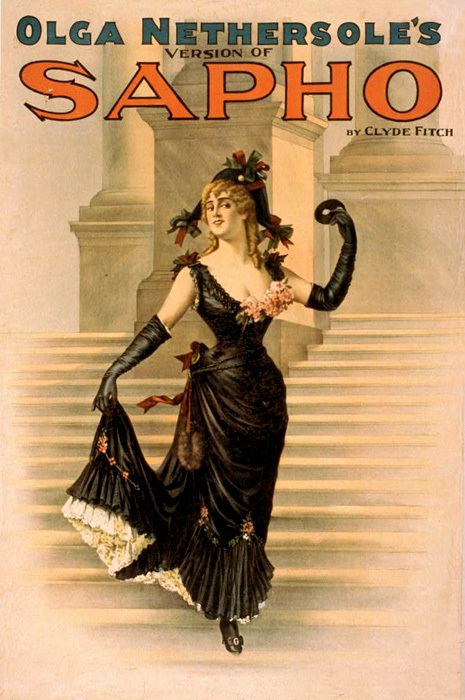 | ||
Sapho was a 1900 American play by Clyde Fitch, based on an 1884 French novel of the same name by Alphonse Daudet and an 1885 play by Daudet and Adolphe Belot. It was at the center of a sensational New York City indecency trial involving the play’s star and producer/director, Olga Nethersole. The play was not an exceptional success but the incident is considered a notable step in the transformation of American society’s attitudes regarding gender roles and public depictions of sex in the 20th century.
Contents
The play
British actress Olga Nethersole asked prominent American playwright Clyde Fitch to adapt Sapho, telling the story from the point of view of the lead female character rather than the male character as was done with the original novel and play. Nethersole produced, directed and starred. The play’s official billing is Sapho, a play in four acts by Clyde Fitch. Founded on the novel by Alphonse Daudet, with scenes from the play by Alphonse Daudet and Adolphe Belot.
Sapho is a so-called “problem play”, centering on a woman who has love affairs with men to whom she is not married. Nethersole had already added two such dramas, Camille and The Second Mrs. Tanqueray, to her ongoing repertoire. Sapho’s lead character, Fanny LeGrand, seduces a naïve man named Jean Gaussin. In the scene that caused the most furor, the two characters ascend a spiral staircase together, presumably toward a bedroom though that is never shown or stated. In the end, LeGrand leaves Gaussin to reform and marry the father of her child.
The play has 23 characters, plus “Danseuses” (dancers).
After out-of-town tryouts in Chicago and other cities, Sapho opened in New York at the old (1882-1904) Wallack’s Theatre on Broadway and 30th Street on February 5, 1900. Reviews were negative and the press predicted it would flop. The show’s notoriety kept it going however, and it ran in New York for a total of 83 performances in 1900. From 1901 through 1913 Nethersole took it on tour to cities throughout America, as well as London and Australia. She brought the play back to New York in 1905, 1908, 1910 and 1913, in the later years sometimes just playing the third act. The play remained controversial, with municipal authorities in some cities continuing to ban performances entirely or insisting on changes in dialogue or costume.
Actors playing Jean Gaussin in the Nethersole productions included Hamilton Revelle (February through May 1900), G. Harrison Hunter (November 1900, and 1910), Slaine Mills (1905), and Winnington Barnes (1913).
The original Broadway choreographer was Carl Marwig and settings were by Ernest Albert.
Indecency trial
Representatives of groups such as the New York Society for the Suppression of Vice, the Society for the Study of Life, and the New York Mother’s Club, protested that the play’s language and costumes were immoral. Some of the outcry was fuelled by yellow journalism, with trial witnesses admitting their tickets had been provided by New York World reporters. New York District Attorney Asa Bird Gardiner ordered Nethersole, her co-star, and two managers arrested on February 21, and police closed the theatre on March 5. Following a month of intense public and press interest (during which Nethersole and her company performed different plays) and a two-day trial, a jury spent 15 minutes acquitting Nethersole and the others. The play reopened two days later, on April 7.
The Sapho indecency trial is a well-known step in the transition from the era of Victorian morality as it existed in America, particularly as regards attitudes toward onstage depictions of gender, intimacy and sex. According to Olga Nethersole’s 1951 obituary, “During the Comstock era...when a public kiss on the mouth was considered an indecency...Nethersole typified the growing revolt against prudery and was a staunch advocate of women’s right and intellectual independence.”
Some historians theorize that the authorities treated Nethersole more harshly than women appearing in other “courtesan” plays because she was a manager in addition to an actress, which upset other contemporary social norms regarding the roles of men and women.
